Indian art's masters of popular aesthetics
Somewhere between the cutting edge and the masters, artists who rule the marquee
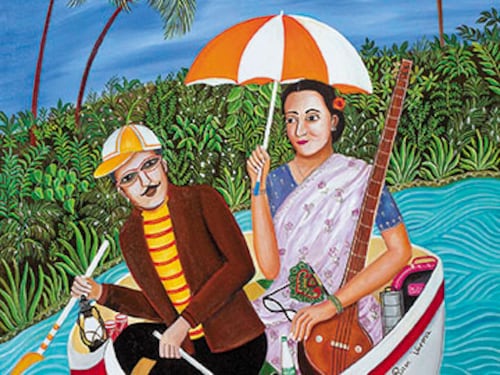

The discourse in visual art is usually articulated around the masters and their legacy, or constructed by the rising stars. As a result, critics and curators tend to marginalise those who base their work on popular aesthetics. Yet, these artists form the bulwark of the market and include well-known names with a consistent body and quality of work. To the public, they represent the face of Indian art without having to carry the burden of social engagement, thereby, believing in art for its own sake.
VIEW AS SLIDESHOW: Indian art: Meet the masters of popular aesthetics
Chasing the bloom
SEEMA KOHLI (b. 1960)
Soham Hansa
Ink and acrylic on canvas with 24 carat gold and silver leaf
68 x 71 inches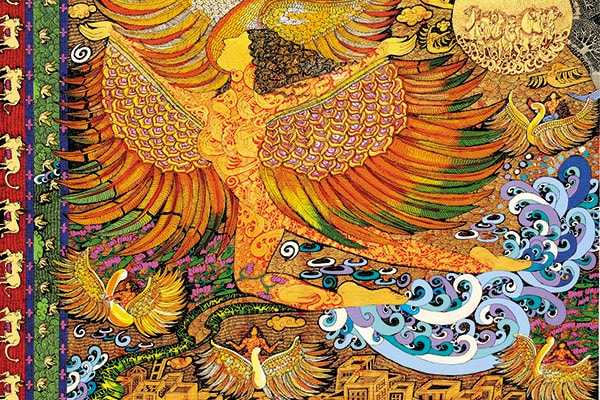 It is unlikely that Seema Kohli, who struggled to break the shackles of a conservative middle-class upbringing, could have foretold her success. Essential to Kohli’s work,
It is unlikely that Seema Kohli, who struggled to break the shackles of a conservative middle-class upbringing, could have foretold her success. Essential to Kohli’s work,
and central to it, is her choice of winged figures seemingly afloat over a universe consisting entirely of lotus blooms, rooted trees and quiet cityscapes.
If the artist’s effervescent colours reflect her view of nature and mankind in organic harmony, the reason is the strife she sees around her. She hopes to arrive at a meditative-like quietness despite her busy palette. These are works that capture her inner struggles and insecurities, and she pays ode to the feminine principle without deflecting or indicting the male principle.
Kohli has read the scriptures and most sacred texts and these imbue her works. Yet they remain secular, never sacred. Her winged women are a reflection of her wanting to break free from socially imposed norms, something she captures in her performance pieces and videos. These penetrating and perceptive artistic practices are underscored by a scathing commentary on perceived notions of propriety and ownership.
Popular on the international art circuit, Kohli has, in recent years, begun to turn the figurative element of her paintings into bronze sculptures, cutting through the confines that artists find themselves slotted into.
Master of the aesthetic
PARESH MAITY (b. 1965)
Eternal Peace
Oil on canvas
54 x 54 inches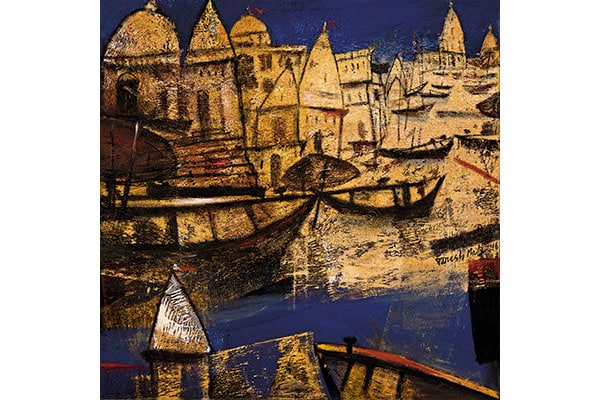 Tamluk, in West Bengal, is a picturesque enough place but that it provided the muse for a rising artist whose star had begun to ascend early in his life was no happenstance. Paresh Maity’s excruciating daily commute to Kolkata to study at the Government College of Art & Craft is the stuff of legends. So is his dedication to water colour landscapes that would ignite the spirit of the Bengal School while invoking an earlier tradition under the influence of John Constable and William Turner. Today, the artist, who is popular and collected around the world, remains the first choice among debuting collectors who can’t seem to get enough of his radiant canvases teeming with faces and evocative landscapes.
Tamluk, in West Bengal, is a picturesque enough place but that it provided the muse for a rising artist whose star had begun to ascend early in his life was no happenstance. Paresh Maity’s excruciating daily commute to Kolkata to study at the Government College of Art & Craft is the stuff of legends. So is his dedication to water colour landscapes that would ignite the spirit of the Bengal School while invoking an earlier tradition under the influence of John Constable and William Turner. Today, the artist, who is popular and collected around the world, remains the first choice among debuting collectors who can’t seem to get enough of his radiant canvases teeming with faces and evocative landscapes.
Over the years, the world has seen less of Maity’s watercolours and more of his acrylic canvases—the airport in Delhi alone has 53 works by him— and occasional sculptures and installations. He cuts a fine figure at art fairs and other events in his tunics embroidered with familiar motifs from his paintings: Parrots, boats, coquettish eyes. A prolific and talented artist, critics are waiting for him to turn his attention from the aesthetic concerns of the commercial market to more serious issues that will involve engaging with social disquiets. The origins of myth
SIDHARTH (b. 1956)
Ganga
Silver leaf and mineral pigments on canvas
72 x 216 inches Known for his use of organic colours obtained from minerals and vegetation and ground to his instructions in his studio, Sidharth’s work has an almost epic quality to it. Often based on sacred texts, he researches extensively on his subject of choice, going back to consecrated myths as well as contemporary contexts, unifying the two along with the observed and experienced.
Known for his use of organic colours obtained from minerals and vegetation and ground to his instructions in his studio, Sidharth’s work has an almost epic quality to it. Often based on sacred texts, he researches extensively on his subject of choice, going back to consecrated myths as well as contemporary contexts, unifying the two along with the observed and experienced.
If, in the past, he had made the cow the subject of his practice, he has spent the last few years conducting research on the Ganga, exploring myth as one element but also investigating its environmental degradation and pollution as elements that have entered its flow. This has meant a good deal of travel, collecting facts, conducting interviews, listening to marginalised voices, while tapping into the repositories of music and dance that play along its shores. This quintessential mode of enquiry is rare in these times when the demands of the art market rarely allow an artist the luxury of such study.
VIEW AS SLIDESHOW: Indian art: Meet the masters of popular aesthetics
The world at home
VINITA KARIM (b. 1962)
Emerald Island
Acrylic, embroidery on Dhaka muslin, gold and copper leaf on canvas
59 x 57 inches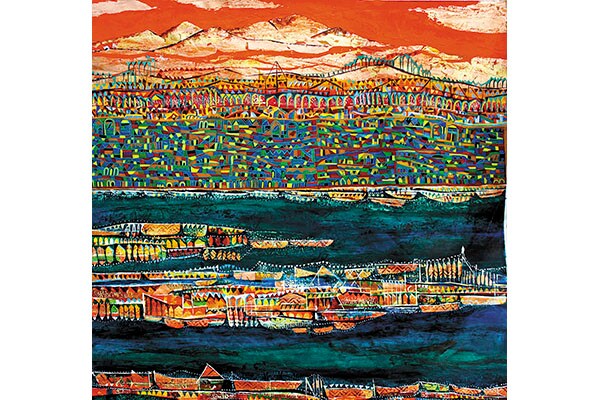 The peripatetic artist, who has made Dhaka her home, is most at ease in her studio where she has brought the world to her hearth. Vinita Karim’s gilt-leafed canvases are set around lands lived and imagined, in histories and geographies of her choosing, places rich with meaning and life despite the physical absence of human figures. Her narratives are built around lifelines of water, in cities with significant sea histories. Established layer by layer, with lines that are repositories of those memories, she combines the blazing sun in Egypt with the waterways in The Philippines, the banks of Tripoli with the lakes of Switzerland. In Dhaka, she has picked on the textile trade, with her embroidered swathes done by communities of workers who have engaged in the craft over generations. It adds an element of global trade to her works.
The peripatetic artist, who has made Dhaka her home, is most at ease in her studio where she has brought the world to her hearth. Vinita Karim’s gilt-leafed canvases are set around lands lived and imagined, in histories and geographies of her choosing, places rich with meaning and life despite the physical absence of human figures. Her narratives are built around lifelines of water, in cities with significant sea histories. Established layer by layer, with lines that are repositories of those memories, she combines the blazing sun in Egypt with the waterways in The Philippines, the banks of Tripoli with the lakes of Switzerland. In Dhaka, she has picked on the textile trade, with her embroidered swathes done by communities of workers who have engaged in the craft over generations. It adds an element of global trade to her works.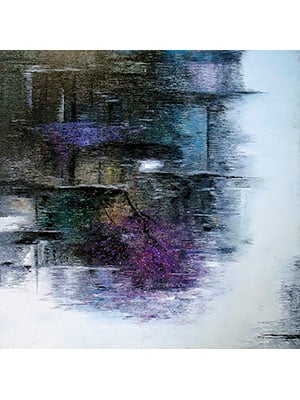
Hold me a mirror
MADHURI BHADURI (b. 1958)
Reflections
Oil on canvas
60 x 60 inches This Pune-based artist of impressionistic landscapes is imbued with a heightened understanding of colour. Almost painstakingly, she returns to her favourite scenes, tweaking their hues as she teases a response from reflections—a favoured trope—in which she finds her oeuvre, whether in waterbodies or rain-swept streets. There was a time when Madhuri Bhaduri’s landscape oeuvre ran to the abstract, but more recently she seems to be irretrievably drawn to some suggestion of form, whether a hut on the horizon or a flotilla of lilies in a pond.
Attracted towards depictions of light in nature, of pearly dawns and flushed sunsets, Bhaduri seems to enjoy the glimpses in her reflections, as reality breaks up in rippled impressions, causing us to look closely at the object of her attention. She paints from memory, increasingly finding a pensive quietness that she seeks out in the confines of her studio. Though she works across mediums, it is oil and canvas that appeal most to her —perhaps because each layer and reflection has the magic possibility of stories untold, left for the viewer to discover at leisure. 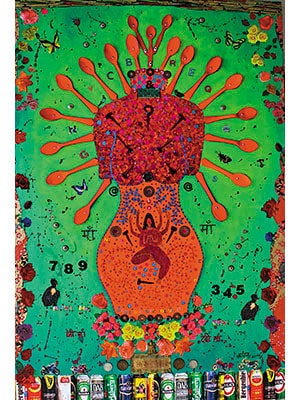 Feminine, feminist
Feminine, feminist
KANCHAN CHANDER (b. 1957)
Devi Nouveau 4
Mixed media on canvas board
48 x 32 inchesThe torso has been central to Kanchan Chander’s work and she has imbued it with all that concerns her: The primal woman and its totemic attribution attenuated through the body proper. If these suggest a feminist viewpoint, it could hardly be wrong, even though Chander has been attracted towards the iconised popularity of cult women —Hollywood and Bollywood divas, and her own role model, the artist Frida Kahlo—whose faces feature in risible assemblages pieced together with lace, sequins and feathers.
This painstaking and laborious homage and deification does not take away from her principled stand of femininity and feminism as complementary ideologies, the one as fantasy and an object of fetish, the other as a symbol of terrific and terrifying power. For her, the body is both trade in stock as well as reverential, both brothel and altar. They question the patriarchal view of society and how women view their own body in its everydayness as well as mystique. 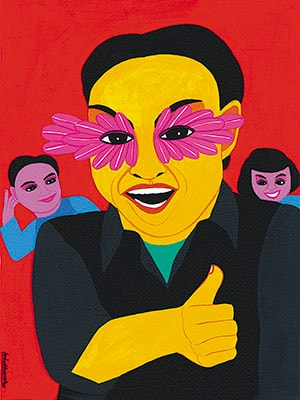 The artist as satirist
The artist as satirist
FARHAD HUSSAIN (b. 1975)
Untitled
Acrylic on paper
12 x 9 inches
No one satirises our highly sexualised society like Farhad Hussain. A keen observer of social trends, Hussain mocks our pet peeves and fears. His paintings are often staged to resemble a farce of the kind that theatre often depicts. Hussain’s cast of characters revolves around the urban middle class, an influential, if inconsistent, constituency that is conservative as a group yet liberal in its individual capacity. He slowly constructs his scenes within the interiors of posh living rooms where the personalities of the protagonists are on open view. Using flat colour tones and an impossibly candy-coloured palette, he accentuates the play of emotions and physicalities, emphasising our response to situations in a farcical way. In these scenarios set within the umbrella of a family are the familiar and the shocking, the banal and the provocative.
In forcing us to think outside our comfort zone, he reinforces stereotypes. The wide-eyed, brightly painted ingénues of his paintings are part of the tapestry of our lives. Each figure in his paintings forms an integral part of the relationships he explores in the form of a tableau or a diorama, lives laid out in front of our eyes as if for dissection and to fuel the rumour mills that keep our social discourses lubricated.
VIEW AS SLIDESHOW: Indian art: Meet the masters of popular aesthetics Romancing the middle class
Romancing the middle class
NAYANAA KANODIA (b. 1950)
Kadabari’s Joyride
Oil on canvas
48 x 36 inches
Within the gentle parlour relationships that she paints with her sardonic eye, artist Nayanaa Kanodia has established the changing nuances in society, often allowing the viewer to be voyeur as well as participant in her delightful cameos of social life in 21st century India. Kanodia’s wickedly warm world is recreated using the naïf or naïve style in which she locates her people—couples mostly—within a quaint interior world of drawing rooms and bedrooms, going about their daily chores, resting, conversing, serving themselves tea, and sometimes stepping out of this enchanted world to treat themselves to a joyride, or shopping trip. Bringing a sense of humour that stops short of parody, she mimics the people who surround us, the charming socialite, the cheerful housewife, the chivalrous partner, even perhaps you and me, located in rooms filled with chintz textiles and period furniture. Folksy and witty simultaneously, Kanodia’s take on society is gentle instead of sharp, delivering a rebuke where necessary, but without the acerbic indictment of so many contemporary artists. The artist lets it be known that this is her own milieu that she finds joy in, warts and all. 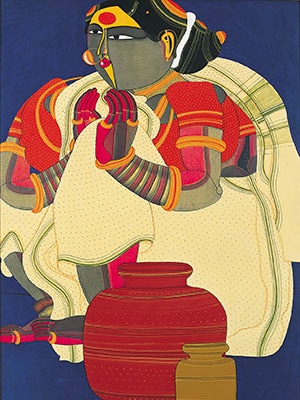 Innocent lust
Innocent lust
THOTA VAIKUNTAM (b. 1942)
Telangana Woman with Pot
Acrylic on canvas
41 x 29 inches
This Telangana-based artist did not have to look far for his muse before chancing on his iconic figures that are so popular among his collectors. There is something immensely appealing about Thota Vaikuntam’s Telangana doppelgangers— voluptuous women in gaily coloured saris, their blouses festooned with beads, their kohl-lined eyes suggestive at once of romance as well as passion, an erotic charge being a suggestive element in his paintings. The figures and their relationships in his works have been the subject of discourses around rural lifestyles and the position of women within its society whose independent femininity and sexuality form the whole and complete context of Vaikuntam’s oeuvre.
VIEW AS SLIDESHOW: Indian art: Meet the masters of popular aesthetics
In a vanishing land
SENAKA SENANAYAKE (b. 1951)
Rainforest
Oil on canvas
48 x 60 inches This well-loved Sri Lankan artist has a huge fan following for his rainforest landscapes with their cheerful colours and dense vegetation amid which bloom anthuriums, birds-of-paradise and exotic tropical plants. What appears at first escapist is a documentation of a rapidly dwindling environment leading to that most catastrophic of disasters: Climate change. Still, in Senaka Senanayake’s’s underbrush, the vegetation is always lush with none of the decay and degradation. Amid the variegated and striped leaves flit butterflies and birds such as hornbills and hummingbirds, and the occasional fauna.
This well-loved Sri Lankan artist has a huge fan following for his rainforest landscapes with their cheerful colours and dense vegetation amid which bloom anthuriums, birds-of-paradise and exotic tropical plants. What appears at first escapist is a documentation of a rapidly dwindling environment leading to that most catastrophic of disasters: Climate change. Still, in Senaka Senanayake’s’s underbrush, the vegetation is always lush with none of the decay and degradation. Amid the variegated and striped leaves flit butterflies and birds such as hornbills and hummingbirds, and the occasional fauna.
Having once entered his rainforest, one parts the canvas leaf by leaf to discover a wonderful world that could arguably exist in a corner of one’s own garden. Senanayake’s forestscapes may consist of parakeets and heliconias but, thankfully, there are no serpents in his paradise.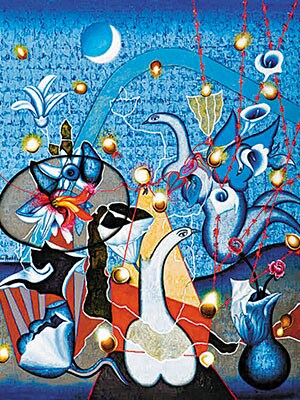 The mortal immortal
The mortal immortal
MANU PAREKH (b. 1939)
Flowers from Heaven XIII
Acrylic on canvas
100 x 80 inches Known principally as a landscape artist for his enduring ode to Benaras, Manu Parekh distills part of it in the manner of still-lifes or temple offerings. For Parekh, these have a subcutaneous erotic layer, a reference to fertility and lushness in nature, akin to human sexuality. Drawn to the idea of this robust sexuality, he notes that it forms part of the sacred in India. The flowering blooms, their intoxicating scents and overpowering attraction for birds and bees, and their consequent state of decay and the passing of life suffuses his canvases. Heady with the fragrance of ritualised ceremonies, Parekh revels in the classical allusion to these floral offerings in an abstracted sense. His representations, then, can be a suggestion of strewn petals, or they can be elaborate arrangements, but the bower he recreates holds within it the secrets of nature itself.
First Published: Jul 02, 2016, 05:30
Subscribe Now(This story appears in the Dec 03, 2010 issue of Forbes India. To visit our Archives, Click here.)